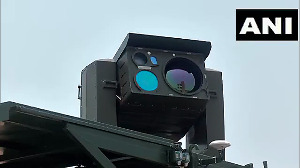Astronauts aboard the space station have found themselves facing a foe far tinier than any rogue asteroid: A joint study by IIT-Madras and NASA's Jet Propulsion Laboratory -- under Principal Investigator Kasthuri Venkateswaran -- has revealed that strains of the bacterial species Enterobacter bugandensis, a multi-drug resistant superbug, have been hitting the gym in the microgravity crucible.
Though the situation at the ISS is slightly unsettling, holding funeral dirges would be an overkill, says Kumar Abishek.

A constellation of panicked headlines recently danced across our screens: 'Sunita Williams in danger?', 'Trouble for Sunita Williams, crew', 'Sunita Williams 'bugged' in space', and so on.
The very notion of this intrepid astronaut and others like her, nestled within the International Space Station (ISS), beset by unseen adversaries, stirred the collective imagination.
Though the situation at the ISS is slightly unsettling, holding funeral dirges would be an overkill.

Astronauts aboard the space station have found themselves facing a foe far tinier than any rogue asteroid: A joint study by the Indian Institute of Technology-Madras and NASA's Jet Propulsion Laboratory -- under Principal Investigator Kasthuri Venkateswaran -- has revealed that strains of the bacterial species Enterobacter bugandensis, a multi-drug resistant superbug, have been hitting the gym in the microgravity crucible.
Now, before you start imagining scenes from a sci-fi movie, allow me to puncture your thought bubble: These aren't alien microbes; they're hitchhikers from Earth that have adapted to the unique environment of the space station.
Near-zero gravity, high radiation, and recycled air with elevated carbon dioxide levels seem to be a perfect evolutionary pressure cooker, turning run-of-the-mill bacteria into potentially tougher opponents.
On Earth, Enterobacter bugandensis is mainly found in clinical specimens, including from the human gut. This usually harmless bacterium can act as an opportunistic pathogen, co-infecting people with compromised immunity.
This bacterial species is also known to transfer its genome or obtain DNA from other organisms -- in other words, it can lead to a 'plethora of infections', said researchers.
Also, the superbug -- which, according to the study, has developed a method to evade the action of many different types of antibiotics -- can persist on the ISS for long periods, co-existing with multiple other microorganisms.
Astronauts' immune systems are weakened by microgravity and radiation exposure, making them relatively susceptible to infections.
Enhanced pathogenicity and virulence of microorganisms in space pose a significant risk to immunocompromised astronauts during long-term missions, and a superbug outbreak in the space station can be catastrophic, thus forcing mission terminations.
Beyond crew health, there's the concern of superbugs contaminating celestial bodies during exploration missions.
If microorganisms from Earth are introduced to extraterrestrial environments, it could disrupt fragile ecosystems that may have evolved in isolation.
But here's the paradox: Space may also offer solutions. Studying these superbugs in the ISS' closed environment allows us to predict their behaviour and develop countermeasures -- vaccines, new antibiotics, or alternative strategies.
Space missions can also act as testing grounds for advanced microbial monitoring technologies.
Early detection of outbreaks is crucial for implementing mitigation strategies and protecting astronauts on long-duration missions like Mars exploration.
In terrestrial settings, insights from space superbugs can boost safety measures at hospital ICUs and surgical theatres.

Williams is the pilot for NASA's Boeing Crew Flight Test and Dyson and Epps are both Expedition 71 Flight Engineers, June 9, 2024. Photograph: Kind courtesy NASA
Microorganisms also carry out life-support functions in space, such as waste degradation, water recycling, and oxygen production.
Studies show that fungi, bacteria, and cyanobacteria can enhance vitamin production and air decontamination under space conditions.
Harnessing fungal biotechnology could lead to self-sustaining space stations in terms of food, pharmaceuticals, and plastic degradation for long-term missions.
Also, microorganisms exposed to space conditions encounter extreme radiation conditions and therefore, develop protective adaptation mechanisms.
Understanding these mechanisms can help us develop ways to protect humans from harmful radiation, in space and on Earth.
Furthermore, a bacterial species -- Bacillus stratosphericus -- normally found 30 km above Earth has been identified as a highly efficient generator of electricity.
Microbial Fuel Cells (MFC) that work in a similar way to a battery use bacteria to convert organic compounds into electricity by a process known as bio-catalytic oxidation.
A biofilm, or 'slime', coats the carbon electrodes of an MFC and as the bacteria feed, they produce electrons that pass into these electrodes and generate power.

Second row from left: Alexander Grebenkin, Tracy C Dyson and Mike Barratt.
At the back: Nikolai Chub, Jeanette Epps and Matthew Dominick, June 6, 2024. Photograph: Kind courtesy NASA
Superbugs in space serve as a reminder that microbial evolution knows no boundaries.
While they pose a threat, they also offer opportunities for scientific advancement and better health practices.
Challenges ahead may involve developing a balanced microflora that maximises life support functions and minimises the threat to crew health in closed space systems.
So, while Sunita Williams might have a new workout buddy on board, it's one we can definitely outsmart.
Feature Presentation: Ashish Narsale/Rediff.com












 © 2025
© 2025